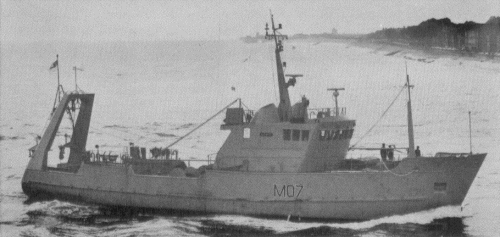
NAVYPEDIA
 Support the project with paypal
Support the project with paypal
Photo

St. David 1978
Ships
| Name | No | Yard No | Builder | Laid down | Launched | Comp | Fate |
|---|---|---|---|---|---|---|---|
| St. David (ex-Suffolk Monarch) | M07 | Cubow, Woolwich | 1972 // 1978 | returned 1984 | |||
| Venturer (ex-Suffolk Harvester) | M08 | Cubow, Woolwich | 1973 // 1978 | returned 1984 |
Technical data
| Displacement standard, t | 382brt |
|---|---|
| Displacement full, t | |
| Length, m | 36.8 wl |
| Breadth, m | 8.90 |
| Draught, m | 3.90 |
| No of shafts | 2 |
| Machinery | 2 Mirrlees-Blackstone EWSL8M(A) diesels |
| Power, h. p. | 2000 |
| Max speed, kts | 11 |
| Fuel, t | diesel oil 95 |
| Endurance, nm(kts) | |
| Armament | mechanical minesweeping gear |
| Electronic equipment | nav. radar |
| Complement | 24 |
Graphics
Project history
To combat the threat from deep-laid mines (mainly to submarines) the RN chartered two commercial stern trawlers in 1977 and four more in 1978, using them with their original crews, but with naval mine warfare specialists on board. These 'Highland Fling' exercises showed that sweep wires could be operated at far greater depths than had been thought, and so a new concept of Extra-Deep Armed Team Sweeping (EDATS) came into being. Special depth-keeping gear allows the sweep wire to follow the contour of the sea-bed, and the depth is believed to be well over 300m. Explosive cutters are attached at 90m intervals.
In 1978 two trawlers were chartered from Small & Co of Lowestoft for manning by RNR crews from the South Wales and Severn Divisions. They had been successful as sweepers but power-generating capacity fell far short of naval requirements.
Modernizations
None.
Naval service
No significant events.
 HOME
HOME FIGHTING SHIPS OF THE WORLD
FIGHTING SHIPS OF THE WORLD UNITED KINGDOM
UNITED KINGDOM MINE WARFARE SHIPS
MINE WARFARE SHIPS VENTURER trawlers-minesweepers (1972 - 1973 / 1978)
VENTURER trawlers-minesweepers (1972 - 1973 / 1978)
